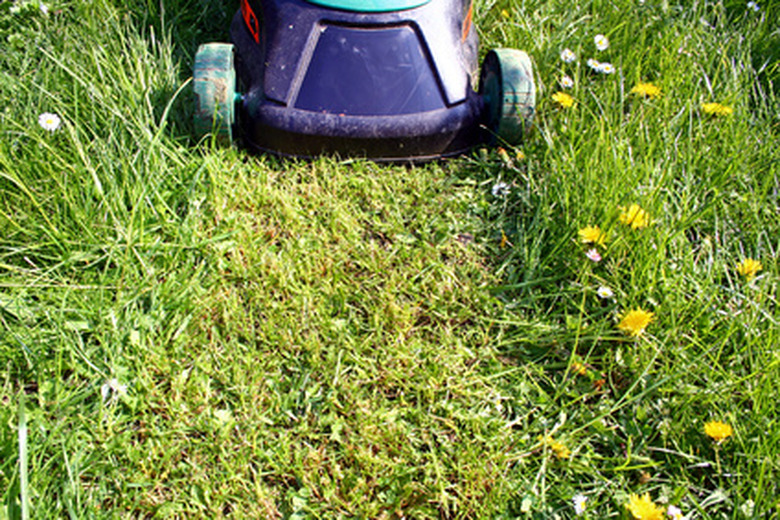Dull Lawn Mower Blades Vs. Sharp Blades
Both lawn grass health and appearance are helped considerably by a homeowner's maintenance of sharp lawn mower blades. By the same token, repeated use of dull blades continually beats the grass up, leaving it ragged and unsightly. Homeowners should take care to always keep their lawn mower blades in sharp condition.
Grass Health
No matter what type of grass is being cut, healthy grass is cut cleanly, with no ragged edges or bruising. Dull blades tear the grass rather than cutting it, and also bruise and otherwise mangle the uncut portions of grass blades. The University of Arkansas Agricultural Extension Service advises that the recovery time for grass to heal after it has been cut is much shorter when it is cut with sharp blades. This allows for less water loss and stronger, healthier grass. Grass weakened by dull lawn mower blade abuse is slower to heal and is more susceptible to diseases, insect damage and heat stress.
- Both lawn grass health and appearance are helped considerably by a homeowner's maintenance of sharp lawn mower blades.
- No matter what type of grass is being cut, healthy grass is cut cleanly, with no ragged edges or bruising.
Appearance
Lawns that are mowed with sharp lawn mower blades have a neat, uniform, green appearance. Conversely, lawns mowed with dull blades have a ragged, brown, dying appearance. As the dull blades bruise and tear the leaves, they turn them a slightly rusty brown. If the tearing continues over multiple mowings, the vascular tissues in grasses become exposed. They look like ragged ivory threads, similar to fraying, unkempt threads on a piece of clothing. When enough pieces of grass look this way, the entire lawn looks tired and unsightly. Lawns mowed with sharp blades do not have this problem.
- Lawns that are mowed with sharp lawn mower blades have a neat, uniform, green appearance.
- If the tearing continues over multiple mowings, the vascular tissues in grasses become exposed.
Time Frame
Mowing a lawn is a cumulative process. The more a lawn is mowed with dull blades, the more damaged it becomes and the more damaged it looks. The more a lawn is mowed with sharp blades, the better and healthier shape it will maintain. The University of Arkansas Cooperative Extension, Kansas State University Extension and Clemson University Extension all advise that homeowners should obey the one-third rule of grass mowing, no matter their preferred height for their lawns. This rule states that no more than one third of the total height of grass should be cut at any one time. Obeying this rule encourages growth, whereas disobeying it actually causes the roots to stop growing and go into a shocked state.
Considerations
Type of grass can also have an affect on mowing. Some grasses, such as rye, are harder on lawn mower blades than others. Since homeowners vary on preferred lawn height, it is not feasible to offer a hard and fast rule on lawn mower blade sharpening. Blades should be sharpened as often as is needed. To determine this, homeowners should take the time to look over their lawns after each mowing, examining the grass closely. Consider the difference between hair fresh from a haircut and hair that needs a haircut. Grass cut by a dull blade looks a bit like scraggly hair with lots of damage and split ends. Grass cut by a sharp blade looks clean and sharp, like a fresh new haircut.
- Mowing a lawn is a cumulative process.
- The University of Arkansas Cooperative Extension, Kansas State University Extension and Clemson University Extension all advise that homeowners should obey the one-third rule of grass mowing, no matter their preferred height for their lawns.
Warning
Failure to maintain sharp blades on lawn mowers will not kill the grass, but it will contribute considerably to its demise. To the untrained eye, this may lead to misidentifying the problem. Tired, ragged lawns that have been abused habitually by dull lawn mower blades may become ravaged by insects and disease, due to their weakened state. Homeowners may think the insects and disease caused the sad looking lawn, rather than correctly identifying the problem and sharpening their lawn mower blades.
